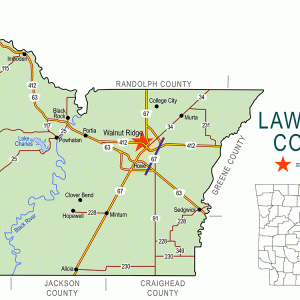calsfoundation@cals.org
Sedgwick (Lawrence County)
| Latitude and Longitude: | 35°58’40″N 090°51’50″W |
| Elevation: | 262 feet |
| Area: | 0.52 square miles (2020 Census) |
| Population: | 163 (2020 Census) |
| Incorporation Date: | February 3, 1894 |
Historical Population as per the U.S. Census:
|
1810 |
1820 |
1830 |
1840 |
1850 |
1860 |
1870 |
1880 |
1890 |
1900 |
|
– |
– |
– |
– |
– |
– |
– |
– |
– |
309 |
|
1910 |
1920 |
1930 |
1940 |
1950 |
1960 |
1970 |
1980 |
1990 |
2000 |
|
96 |
195 |
137 |
152 |
196 |
206 |
168 |
205 |
86 |
112 |
|
2010 |
2020 | ||||||||
|
152 |
163 |
Sedgwick, a town in eastern Lawrence County, is located on U.S. Highway 63 between Hoxie (Lawrence County) and Jonesboro (Craighead County).
At the beginning of the nineteenth century, Osage from farther north hunted and fished in the area that would become northeastern Arkansas, but they had no permanent settlements there. Even after Arkansas became a state, settlement in the Cache River basin remained sparse. Eventually, after the Civil War, investors began to consider harvesting the timber in this part of Arkansas. The Kansas City, Fort Scott and Memphis Railroad built a line in the 1880s that ran through Hoxie and Jonesboro on the way to Memphis, Tennessee. George Washington Sedgwick, one of the railroad’s organizers, built a sawmill near the Cache River, and a depot was built to load timber onto the railroad cars. The depot and the post office that opened in the depot in 1883 were named for Sedgwick (not for Civil War general John Sedgwick, as some claim). Edith Sedgwick, George’s wife, was the first postmaster at Sedgwick. The Sedgwick Tie Company sold lumber to the railroad.
Sedgwick also created a spur line into the forest to bring logs to his sawmill. Originally chartered in 1882 as the Black and Cache River Railroad, it was generally known as the Cache Valley Railroad. By 1900, the line included twenty-four miles of narrow gauge track, but in 1902 it was shortened to nineteen miles and, in 1904, converted to standard gauge. The line ceased operating in 1927.
More people began building homes and establishing businesses near the depot and sawmill, and the town of Sedgwick was incorporated in 1894. George Sedgwick donated land and material to build a schoolhouse; Dora Smith was the first teacher in the school. A Baptist congregation was organized in 1907. The members met in the Sedgwick schoolhouse until they constructed their first church building in 1921.
Construction of a highway running from Mammoth Spring (Fulton County) to Memphis began around 1920. First known as Arkansas Highway 7, it later became part of U.S. Highway 63, which still runs through Sedgwick in the twenty-first century. Electricity first came to Sedgwick in 1935 under the auspices of the Rural Electrification Administration. With modernization came change; the Sedgwick school was eventually consolidated into the Hoxie School District.
In 2000, businesses in Sedgwick included a restaurant, a construction company, and a machine shop. These had all closed by 2015, leaving Sedgwick with a Baptist church, a post office, and a volunteer fire department. The population began to grow, however, as more people who worked in Jonesboro, Hoxie, and Walnut Ridge (Lawrence County) chose to live in a small-town environment.
For additional information:
Berry, Mary. “Sedgwick and Its Railroad.” Craighead County Historical Quarterly 3 (Autumn 1965): 24–26.
Mother of Counties: Lawrence County, Arkansas, History and Families. Paducah, KY: Turner Publishing Company, 2001.
Steven Teske
Butler Center for Arkansas Studies
 Lawrence County Map
Lawrence County Map 



Comments
No comments on this entry yet.